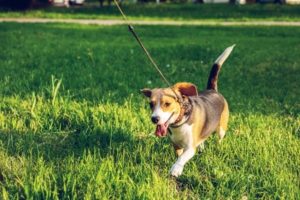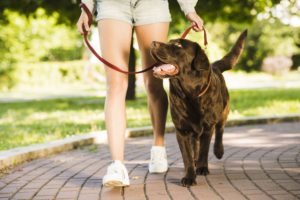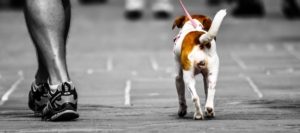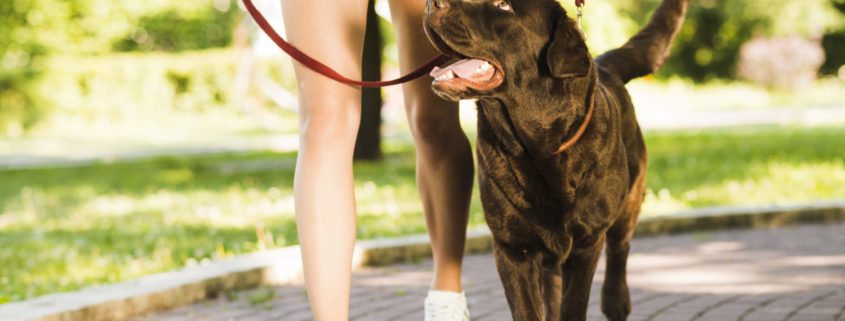Ask Crystal: Walking a Fast Dog
Welcome to “Ask Crystal,” where you can ask your pet behavior questions! You can submit your question for Crystal at the bottom of the page!
Dear Crystal,
I need your help. I try to take my dog to the park for long walks to burn energy but walking her is really unpleasant. She pulls on the leash so hard; I feel like my arm is about to come out of the socket. She looks like she is trying to win a sled dog race. I am so embarrassed. I try to hold the leash tight by my side, so she is in the right position, but it cuts the circulation off to my hand and it doesn’t seem to be helping. I feel like I have tried everything, and nothing seems to be working. Please help!
Sincerely,
Sled dog no more
Dear Sled,
 I am sure there are a lot of dog owners nodding their heads out there in agreement with you. Leash walking is one of the most common issues people want to work on in training classes. It seems the majority of dogs just really don’t want to walk very slowly by our sides. Why ever could that be? The first thing to understand is the difference in our gait. Humans walk while most dogs move from point A to B at a trot. Most dogs cannot comfortably trot as slow as a human will walk. There may be some element of discomfort on the dog’s part to walk as slowly and inconsistently as most humans walk. Another reason that most people seem to understand is that the dog is excited to get to things. There are so many things to look at and smell. One of the things we love so much about our dogs is there excitement about life, except when it comes to walking it seems. We move too slow and we aren’t exciting enough. Dogs don’t just know that we want them to walk by our side. We need to show them what we want and reinforce it heavily. By reinforcing the behavior frequently and with very high value treats, we can help to make ourselves more interesting and make it worth the dog’s while to stay near us.
I am sure there are a lot of dog owners nodding their heads out there in agreement with you. Leash walking is one of the most common issues people want to work on in training classes. It seems the majority of dogs just really don’t want to walk very slowly by our sides. Why ever could that be? The first thing to understand is the difference in our gait. Humans walk while most dogs move from point A to B at a trot. Most dogs cannot comfortably trot as slow as a human will walk. There may be some element of discomfort on the dog’s part to walk as slowly and inconsistently as most humans walk. Another reason that most people seem to understand is that the dog is excited to get to things. There are so many things to look at and smell. One of the things we love so much about our dogs is there excitement about life, except when it comes to walking it seems. We move too slow and we aren’t exciting enough. Dogs don’t just know that we want them to walk by our side. We need to show them what we want and reinforce it heavily. By reinforcing the behavior frequently and with very high value treats, we can help to make ourselves more interesting and make it worth the dog’s while to stay near us.
 There are different types of walks that you may want to take with your dog. In my class, I teach a steady cue which means when I call you over and tell you “steady” the dog should walk by my side while maintaining eye contact. I don’t expect my dogs to walk like this all of the time. That would be asking a lot of the majority of dogs and probably wouldn’t make for a very fun walk. I use the “steady” cue any time my dog starts to pull me or if there is something that I don’t want them to focus on like another dog. I usually release them after we get past the other dog or once I see they have calmed down and stopped pulling. The real upside I have noticed with my own dogs is that they begin to offer the walking by my side and eye contact on their own without being asked. I reinforce this heavily especially in the beginning stages of training or in high distraction environments. Heavy reinforcement might be every couple of steps in the beginning. We can start to slowly work on reinforcing for more steps in between treats as the dog really starts to get the hang of the behavior. How I get to this point is a series of games that I play that breaks the behavior down into smaller more manageable pieces. Games make learning so much more fun for the dog and for the human.
There are different types of walks that you may want to take with your dog. In my class, I teach a steady cue which means when I call you over and tell you “steady” the dog should walk by my side while maintaining eye contact. I don’t expect my dogs to walk like this all of the time. That would be asking a lot of the majority of dogs and probably wouldn’t make for a very fun walk. I use the “steady” cue any time my dog starts to pull me or if there is something that I don’t want them to focus on like another dog. I usually release them after we get past the other dog or once I see they have calmed down and stopped pulling. The real upside I have noticed with my own dogs is that they begin to offer the walking by my side and eye contact on their own without being asked. I reinforce this heavily especially in the beginning stages of training or in high distraction environments. Heavy reinforcement might be every couple of steps in the beginning. We can start to slowly work on reinforcing for more steps in between treats as the dog really starts to get the hang of the behavior. How I get to this point is a series of games that I play that breaks the behavior down into smaller more manageable pieces. Games make learning so much more fun for the dog and for the human.
The first thing to begin working on is name recognition. How I define name recognition is, the dog hears its name, turns its head and comes running over to me. I need name recognition because I need to be able to call the dog back to me anytime they start pulling. We play a really fun game called the Name Game to teach a really awesome name recall. Practice this behavior inside the house where the distractions are low. When your dog is turned away, call their name in a high-pitched voice. When they turn their head to look at you, say “yes” and hold a treat by your leg. Practice this game several times a day at minimum. Once the dog really has the behavior inside the house, this would be the first thing to start working on outside. If you can’t get your dog’s attention, you can’t expect to get them to walk nicely.
Another important skill to be working on is eye contact. Again, inside the house, practice standing in front of your dog and treating them for any offered eye contact. When the dog is really getting the behavior, you can start to practice this outside. Reinforce any offered eye contact by your dog when you are outside. This means you always need to carry treats when you go outside with your dog. If you don’t have treats and good ones at that, you are missing opportunities to reinforce good behavior.
 The next game is about teaching the dog to want to hang out by our side. We drop a treat on the ground, right next to our left foot. While the dog is eating the treat, we take a step to the right and call our dog’s name. As the dog is coming towards me, I say “yes” and treat by my leg right next to the dog. I take a step away because it grabs the dog’s attention and helps to get them in the correct position. I am just taking one step at a time to make it very easy. As the dog begins to get the game, I start to insert my verbal steady cue. We do the same thing but after we say the dog’s name, we say steady so that we insert the cue where it goes in the sequence. Then it just becomes a matter of gradually increasing the number of steps we are looking for.
The next game is about teaching the dog to want to hang out by our side. We drop a treat on the ground, right next to our left foot. While the dog is eating the treat, we take a step to the right and call our dog’s name. As the dog is coming towards me, I say “yes” and treat by my leg right next to the dog. I take a step away because it grabs the dog’s attention and helps to get them in the correct position. I am just taking one step at a time to make it very easy. As the dog begins to get the game, I start to insert my verbal steady cue. We do the same thing but after we say the dog’s name, we say steady so that we insert the cue where it goes in the sequence. Then it just becomes a matter of gradually increasing the number of steps we are looking for.
The next game, we stop dropping treats on the ground. We call our dog’s name, when they make eye contact, we say “steady” and turn away. We reinforce the dog staying by our side and maintaining eye contact. Eventually we get to a point where we can just start walking straight without turning away, but we decrease the number of steps we take initially. Each of these games is putting together a small piece of the puzzle until we get to the final behavior.
One of the mistakes I commonly see students make is that the don’t reinforce enough. We need to make this exciting and very motivating for the dog to want to continue this behavior. I also try to encourage students to add steps very slowly as the dog is getting better and better so that we aren’t making it too hard too soon. The biggest mistake that I see is not practicing enough inside the house before training outside. I recommend that you play these training games inside the house a lot. Then start to play in your backyard, front yard, garage and driveway. Then practice walking straight down your own road. After a good amount of practice, then maybe at the end of a walk in the park your dog might be tired enough to do some training. And eventually they will be able to do the majority of the walk.
In the meantime, I suggest a no-pull harness or head halter. We like to use the harnesses here because they don’t take a desensitization training like the head halters do. Most dogs you can just put the harness right on. The no pull harnesses usually work by discouraging pulling because when the dog pulls it turns her back towards you. A traditional harness connects on the back and can often cause the dog to push into the pulling because of oppositional reflex. You should always carry treats and when the dog pulls stop walking. Call the dog back to you or take a couple quick steps backwards to get them to follow. We don’t start moving again until the leash is slack. Reinforce any walking by your side to motivate the dog to want to be there.
I see a lot of people tightening up on the leash and pulling the dog around. It is important that you realize when you hold the leash tight and pull the dog around, the dog isn’t learning anything. The dog needs to make the moves to be by your side of their own volition. Yes, there are going to be times when you need to pull your dog away from something for safety. However, when we are training, we should always keep the leash slack and let the dog make the decisions to come closer.
There are many ways to teach everything so hopefully you can find the method that works for you. I find it helpful to understand some of the reasons behind why dogs behave the way they do when thinking about how to change their behavior. We need to show the dog where we want them to be and give them a reason to want to do things our way.
Until next time,
Crystal







